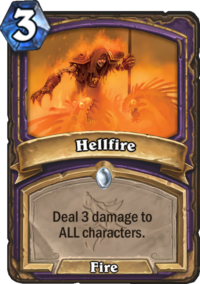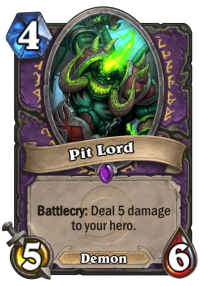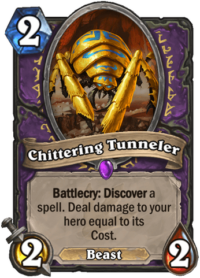It is reveal season in the lands of Hearthstone, and with the new Standard year approaching faster and faster, deck builders prepare to come up with the hottest and most overpowered archetype right after the release of The Witchwood.
As it was with the first Standard rotation last year, almost all classes will again receive a natural facelift due to the loss of important core cards. Looking at the revealed card list so far, one class stands out in terms of archetypical changes: Warlock. The class received three new cards, Blood Witch, Deathweb Spider and Duskbat, who all share a similar base mechanic: Damaging your own hero for the greater good.
How will these new cards shape the iconic Hearthstone class, and will this new archetype be able to compete with what many see as the upcoming meta champion, Control Warlock?
History Repeats Itself

Back in the old World of Warcraft days, the Warlock class fantasy heavily evolved around self-inflicted damage. Core skills like Life Tap and Hellfire had to sacrifice health points to regain mana or do exceptional amounts of area damage.
That fantasy transferred to Hearthstone as well. The Warlock’s Hero Power Life Tap has been declared the best in the game ever since, showcasing the great potential behind the Warlock motto “give much, gain much”.
Cards with similar effect got printed throughout the history of Hearthstone; cards like Flame Imp continued to show both the power and the drawback of the Warlock class fantasy. However, there has always been a fine line between a viable or a useless combination of the two; Pit Lord, for example, who uses the same mechanic as Flame Imp, has rarely seen play since the release of the game. Why is that?
Life is Important After All


Well, first of all, Pit Lord offers only 2.75 stats per mana spent, while Flame Imp provides 5 stats for just 1 mana. Would Pit Lord see play if it was a 6/7 or 7/6? Maybe not now, but it would have been a strong minion back in the Classic days. That logic applies to a lot of cards that influence Warlock’s life total: They are just not worth it to play due to lack of synergy or power level.
Another reason lies within the dilemma of using your Life total as a resource: Over the course of the game, Life gets more and more important. Board presence becomes more powerful, opponents have more mana to spent for threatening combos. That doesn’t count for the earlier stages of the game, increasing the value of mechanics behind Life Tap and Flame Imp indefinitely.
However, this drawback which increases with the length of the game can be compensated by one single thing, and that is healing.
Cards with healing effects are few and far between, not at least because of their initial sheer power during the Classic days where value mattered most, and that especially applied and still applies to Warlock.
With Kobolds and Catacombs, Team 5 decided to give back what Warlock players demanded for over two years; Warlock’s spellstone, Lesser Amethyst Spellstone, and Dark Pact provide tons of healing for a comparably small amount of card investment. Mostly due to the addition of these cards, Warlock became a threat in the meta again as of today.
The Last Puzzle Piece

The addition of healing for Warlock during Kobolds and Catacombs and the reveal of the three new cards surely is enough to think about a new Warlock archetype based on dealing damage to your very own face. Based on this mechanic, some very powerful cards could finally make the cut to get into a list like Infliction Warlock:
Vulgar Homunculus
This beautiful creature has already seen play in various Zoolock lists. A 2 mana 2/4 with no real drawback in a mid-range tempo kind of deck should be an auto-include, and we have already seen a card with similar stats dominate the meta: Wyrmrest Agent.

Chittering Tunneler
One of the most underrated cards in terms of hidden power level. With the upcoming Standard rotation and the amount of useful spells in the pool of cards, this little bugger will almost always pull out a useful spell that can either enable unexpected board clear or even more self-healing. Besides that, it is a 3/3 for 3 mana after all, something that has been played regularly on board in the form of Silverware Golem.
Hooked Reaver
A whole community was incredibly hyped about this card when it first got announced, and it could finally find a place in our new Warlock archetype. The stat line is exceptional for its mana cost; however, getting in 15 damage on turn 4 seems borderline suicidal and really only achievable with the next card.
Bloodbloom
One of the most creative and “high risk high reward” cards in the Warlock toolkit. There have been quite a few shenanigan decks around which included Bloodbloom in combination with Violet Illusionist and DOOM! in the past. In Infliction Warlock, this card can be used as a last minute insurance to cheat out removal or significant self-healing, sacrificing the great good for the even greater good!
Other cards like Kobold Librarian and Flame Imp already see regular plays in several Warlock archetypes and would fit the general mid-range theme of Infliction Warlock.
The archetype could get completed by the usual Demon package including Despicable Dreadlord and Bloodreaver Gul'dan. Gul’dan can be seen as the top-end card that rounds out the mana curve, comparable to N’Zoth Tempo Warrior, one of the more successful true tempo mid-range decks in the past.
Por que no los dos?
But one question still remains: Why would anyone try to build a new Warlock archetype when Control Warlock looks to reign the meta game in the new Standard year?
First of all, this archetype called Infliction Warlock perfectly showcases the true fantasy behind the Warlock class. Decks like Freeze Mage or Aggro Hunter show that many members of the community really love to play lists that fit the original class identity.
The natural development of the meta game at the beginning of an expansion is another reason why this archetype could make a meaningful appearance with the release of The Witchwood. The past has shown that mid-range tempo decks perform really well, especially against super greedy decks with new mechanics. The more refined the meta gets, the more greed will get rewarded by running hyper-control lists, just as it is right now at the end of the expansion. That being said, Control and Cube Warlock already have problems against mid-range lists like Miracle Rogue, so picking another archetype in the early stages of the meta game could make total sense based on the development of other class decks.
In the perfect world, all Warlock archetypes will live peacefully tree by tree in The Witchwood. And while this may not eventually happen, Warlock could certainly profit from a new archetype that embraces the one and only class fantasy of hurting itself for the greater good.

I myself am a 100% warlock player, so it’s not surprising that my current favourite deck is one of the hyperpopular control warlock ones. Although I believe control warlock will remain the objectively best type of decks for this class, this article really makes me want to build an infliction warlock deck as soon as the new expansion is released, but i personally believe both blood witch and that new lifesteal spider aren’t good enough to be used, even in decks that make perfect use of their abilities. Do you think its still possible to build a respectable infliction warlock deck without these two cards?
The development of this archetype, or “deck idea”, which might be more fitting in this regard, is pretty similar to the Tempo Warrior evolution.
One of two things will eventually happen: More and more cards are printed to fit that idea, and that will cause the deck to be “invented” as a whole, if that makes sense. The other thing that we have seen more regularly is that some of these “deck idea” cards will make it into other archetypes who already exist.
I can see Duskbat work pretty well in Zoolock, especially in combination with Vulgar Homunculus and Kobold Librarian. The other two cards will make the cut if the meta turns out to be more mid-range heavy, something that could very well happen.
So they use FlintLocs in Gilneas? That’s pretty cool. Can’t wait to see what happens.
Sounds like a fun deck to check out. Could you post a theorycraft deck based on this article?
Something like this?
http://www.hearthstonetopdecks.com/decks/theorycraft-inflication-warlock/
Almost exactly the list I wanted to post, looks good!
I would find a place for Countess Ashmore to get Spellstone and Voidlord.
Nice suggestion. Would you swap Doomguard for Countess Ashmore? The rest seems crucial to the deck.
Solid article. Good explanation, and important callouts of cards that have been ignored in the past for the most part. Let’s hope this kind of deck does work out, as I’m a midrange tempo style player in general, and this kind of deck is one I’d really enjoy.
Need more well reasoned, clearly written articles like this.
Thank you for the great feedback! I too hope that this deck finds its place in the meta-game, and I’m convinced that it can rake in some wins, especially during the first chaotic weeks after Witchwood’s release.